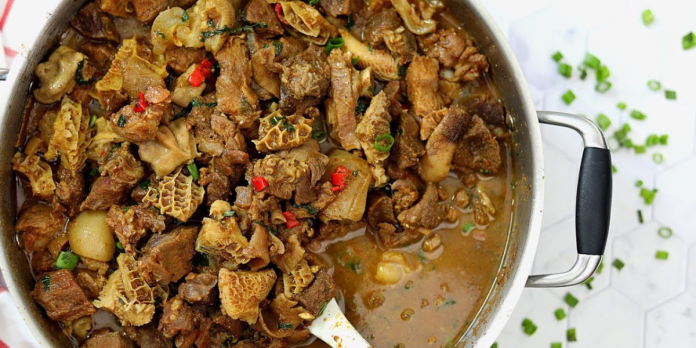Table of Contents
Nigeria is home to a wide array of diverse and flavorful dishes, making Nigerian dinner ideas as vibrant as its culture. Whether you’re looking for something hearty, spicy, or light, Nigeria’s culinary offerings cater to every palate. In this article, we’ll explore the top ten Nigerian dinner ideas, with dishes ranging from the classic Jollof Rice to the savory Nkwobi. Each dish is steeped in tradition, rich with flavor, and loved across the nation. These Nigerian dinner ideas are not just meals, but they also carry cultural significance, providing a taste of Nigeria’s heritage with each bite. Let’s dive into the top 10 Nigerian dinner ideas that are sure to leave you satisfied and craving more.
1. Fried Rice: A Flavorful Nigerian Dinner Idea ( Nigerian dinner ideas)
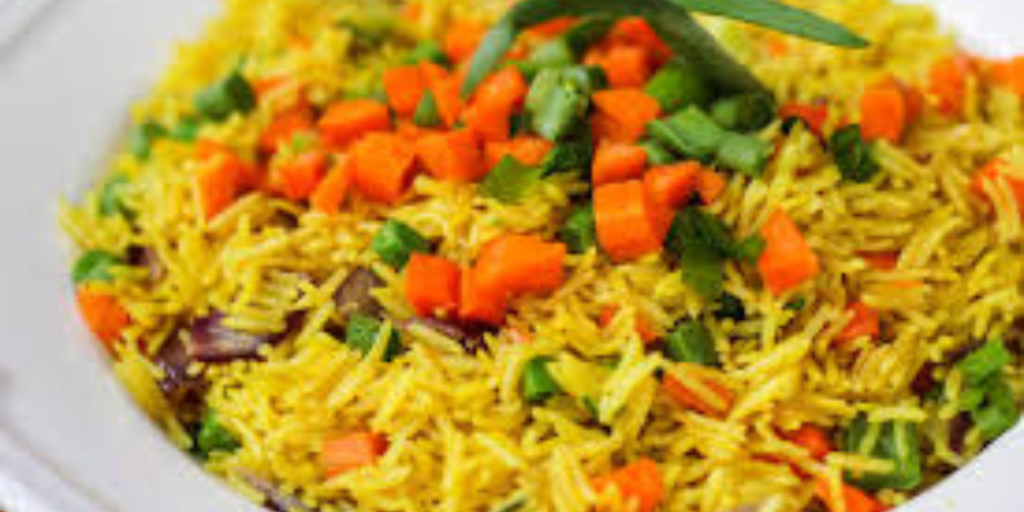
Fried Rice is a popular dinner option in Nigeria, often served at parties, celebrations, and family gatherings. This dish is known for its vibrant colors and mix of vegetables, proteins, and rice, making it both visually appealing and delicious. Nigerian Fried Rice stands out because of its unique blend of ingredients and spices, which give it a distinct taste compared to its Asian counterpart.
Ingredients for Nigerian Fried Rice ( Nigerian dinner ideas)
To make Nigerian Fried Rice, you’ll need the following ingredients:
- Parboiled long-grain rice
- Mixed vegetables (carrots, peas, sweet corn, green beans)
- Diced chicken or shrimp (optional)
- Liver (optional)
- Green bell peppers
- Onions
- Seasoning cubes
- Curry powder and thyme
- Vegetable oil
- Salt and pepper to taste
How to Prepare Nigerian Fried Rice
Step 1: Prepare the Rice
The first step in preparing Fried Rice is to parboil the rice. This ensures that the rice is partially cooked but still firm. After parboiling, rinse the rice under cold water to remove excess starch and set it aside.
Step 2: Stir-Fry the Vegetables
In a large pan or wok, heat vegetable oil and add finely chopped onions, bell peppers, and other vegetables. Stir-fry the vegetables for a few minutes, allowing them to become tender but not overcooked. If you’re using chicken, shrimp, or liver, cook them in a separate pan before adding them to the vegetables.
Step 3: Season the Rice
Once the vegetables are cooked, add the parboiled rice to the pan. Season the mixture with curry powder, thyme, salt, and pepper. Stir everything together until the rice is evenly coated with the spices. Allow the rice to fry for about 10-15 minutes, stirring occasionally to prevent it from sticking to the pan.
Step 4: Serve
Nigerian Fried Rice is often served with a side of fried chicken, plantains, or even a salad. The dish’s colorful appearance, thanks to the variety of vegetables, makes it a visually striking dinner option that is both nutritious and flavorful.
Nigerian dinner ideas | Best 5 Nigerian Dinner Ideas
Variations of Nigerian Fried Rice ( Nigerian dinner ideas)
- Shrimp Fried Rice: Add shrimp to your Fried Rice for a seafood twist. Shrimp adds a delicate sweetness to the dish that complements the spices.
- Chicken Fried Rice: Chicken is a popular protein choice, adding heartiness and flavor to the meal.
- Vegetarian Fried Rice: Omit the meat and seafood, and focus on a variety of vegetables for a healthier option.
The Cultural Significance of Fried Rice in Nigeria
Fried Rice is often considered a party dish in Nigeria, commonly served alongside Jollof Rice at weddings, birthday parties, and festive celebrations. Its versatility allows it to be paired with a wide range of proteins and side dishes, making it a favorite for large gatherings. The dish is also popular for Sunday dinners when families come together to enjoy a special meal.
Nutritional Value of Nigerian Fried Rice
Fried Rice is a well-balanced meal, providing a combination of carbohydrates from the rice, vitamins and fiber from the vegetables, and protein from the chicken or shrimp. The use of vegetable oil adds healthy fats to the meal, making it a wholesome option for dinner.
2. Jollof Rice: A Nigerian Dinner Classic ( Nigerian dinner ideas)
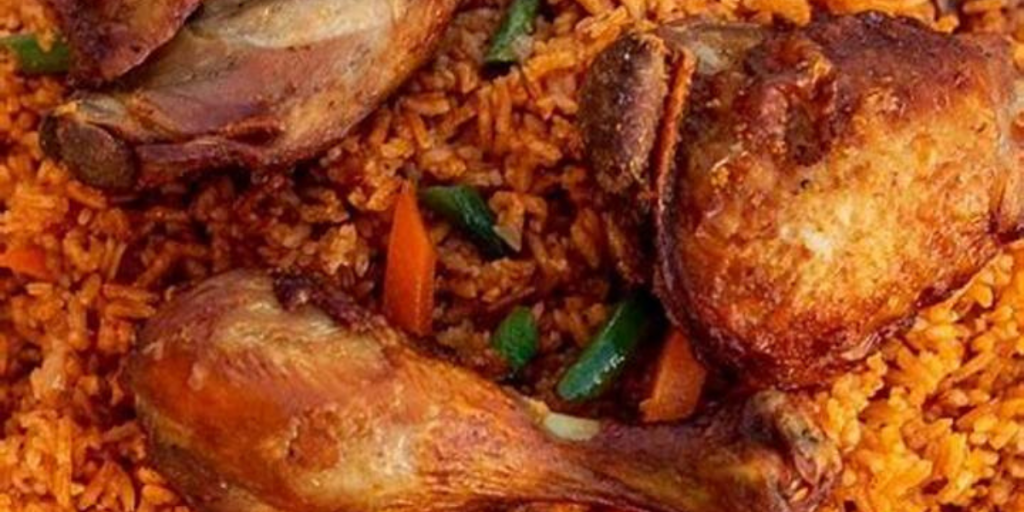
Jollof Rice is arguably the most famous Nigerian dish, not just within the country but across West Africa. This one-pot rice dish, made with tomatoes, onions, and a blend of spices, is a staple at Nigerian parties, weddings, and family dinners. Its rich red color and bold flavors make Jollof Rice a beloved dinner choice across Nigeria.
Ingredients for Jollof Rice ( Nigerian dinner ideas)
To make Jollof Rice, you’ll need the following ingredients:
- Long-grain parboiled rice
- Fresh tomatoes or tomato paste
- Red bell peppers and scotch bonnet peppers
- Onions
- Vegetable oil
- Chicken or beef stock
- Seasoning cubes
- Thyme, curry powder, bay leaves
- Salt and pepper to taste
How to Prepare Nigerian Jollof Rice ( Nigerian dinner ideas)
Step 1: Prepare the Tomato Base
Start by blending fresh tomatoes, red bell peppers, and onions into a smooth paste. In a large pot, heat vegetable oil and add finely chopped onions. Fry the onions until golden brown, then add the blended tomato mixture. Cook this mixture for about 20-30 minutes until the oil begins to separate from the sauce, indicating that it’s well-cooked.
Step 2: Add the Rice and Stock
Once the tomato base is ready, add the parboiled rice to the pot, followed by chicken or beef stock. Season the rice with thyme, curry powder, bay leaves, and seasoning cubes. Stir the mixture well, ensuring that the rice is fully submerged in the tomato sauce. Cover the pot and allow the rice to cook on low heat for about 20-30 minutes, stirring occasionally to prevent burning.
Step 3: Serve
Once the rice is fully cooked and has absorbed the rich tomato flavors, it’s ready to be served. Jollof Rice is often served with fried chicken, fish, or beef, along with fried plantains or a side salad.
Variations of Jollof Rice
- Party Jollof: This variation is often smokier and slightly spicier, giving it a distinct flavor that is highly sought after at Nigerian parties.
- Vegetable Jollof: Add a variety of vegetables like carrots, peas, and bell peppers to make the dish more nutritious.
- Seafood Jollof: Shrimp or prawns can be added to Jollof Rice for a seafood twist.
The Cultural Significance of Jollof Rice in Nigeria ( Nigerian dinner ideas)
Jollof Rice is more than just a meal in Nigeria; it’s a cultural symbol. The dish has become a point of pride, with many Nigerians claiming to make the best Jollof. In fact, there’s a friendly rivalry between Nigeria and other West African countries like Ghana and Senegal over who makes the best version of Jollof Rice. It’s also a dish that brings people together, often served at large gatherings and special occasions.
Nutritional Value of Jollof Rice
Jollof Rice is a great source of carbohydrates from the rice, while the tomatoes and peppers provide vitamins and antioxidants. The dish can be paired with protein-rich sides like chicken or fish, making it a balanced and nutritious meal.
Health Benefits of Zobo Drink Without Sugar Best of 2024
3. Amala: A Starchy Nigerian Dinner Delight ( Nigerian dinner ideas)
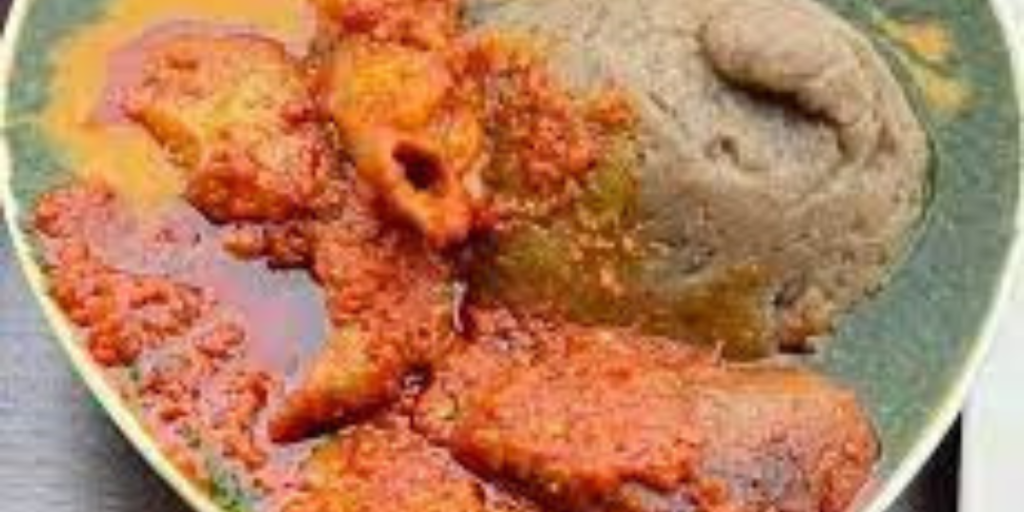
Amala is a traditional Nigerian dish made from yam flour (elubo). It’s a popular dinner option in the southwestern part of Nigeria, particularly among the Yoruba people. Amala is typically served with soups like ewedu or gbegiri, creating a hearty and satisfying meal.
Ingredients for Amala
To make Amala, you’ll need the following ingredients:
- Yam flour (elubo)
- Water
- Ewedu soup or gbegiri (bean soup) for serving
How to Prepare Amala ( Nigerian dinner ideas)
Step 1: Boil Water
Start by boiling water in a pot. The amount of water you use depends on the quantity of Amala you want to prepare. It’s important to get the right consistency, so use enough water to cook the flour without making it too thick or too watery.
Step 2: Add Yam Flour
Once the water reaches a rolling boil, reduce the heat and gradually add the yam flour, stirring continuously with a wooden spoon. As you stir, the mixture will begin to thicken and form a smooth, elastic dough. Continue stirring until there are no lumps, and the Amala is smooth and stretchy.
Step 3: Serve
Amala is typically served in a rounded mound alongside soups like ewedu or gbegiri. To eat Amala, pinch off a small piece, dip it into the soup, and enjoy.
Variations of Amala
- Amala with Ewedu and Gbegiri: This is the most common pairing, combining the smoothness of Amala with the slimy texture of ewedu and the earthy flavor of gbegiri.
- Amala with Egusi Soup: Amala can also be served with Egusi soup, offering a different flavor profile and texture.
- Amala with Ogbono Soup: For those who enjoy a more viscous texture, Amala pairs well with Ogbono soup.
The Cultural Significance of Amala in Nigeria ( Nigerian dinner ideas)
Amala is more than just a meal in Nigeria; it’s a cultural staple, particularly among the Yoruba people. It’s commonly served at weddings, naming ceremonies, and other special occasions. Amala’s simplicity and versatility make it a beloved dinner option, whether served at home or at large gatherings. It’s also a symbol of pride for the Yoruba, who have perfected the art of making this starchy delight.
Nutritional Value of Amala
Amala is a good source of carbohydrates, providing energy for the body. When paired with protein-rich soups like ewedu or gbegiri, it becomes a balanced meal that is both filling and nutritious. The yam flour used in Amala is also high in fiber, making it a healthy option for those looking to improve digestion.
4. Eba: A Staple Nigerian Dinner Idea ( Nigerian dinner ideas)

Eba is one of the most common and beloved Nigerian dinner ideas. Made from garri (cassava flakes), Eba is typically served with a wide variety of soups such as Egusi, Ogbono, or Okra. Its versatility and simplicity make it a favorite across Nigeria, especially in the southern and western parts of the country. Eba is a filling and nutritious option, ideal for dinner, and is often enjoyed with hands, which adds a more cultural and personal touch to the meal.
Ingredients for Eba
To make Eba, you’ll need:
- Garri (cassava flakes)
- Boiling water
- Any Nigerian soup (e.g., Egusi, Okra, or Ogbono) for serving
How to Prepare Eba ( Nigerian dinner ideas)
Step 1: Boil Water
Start by boiling water in a kettle or pot. The water should be enough to cover the amount of garri you intend to prepare.
Step 2: Add Garri to the Boiling Water
Once the water has reached boiling point, pour it into a bowl. Gradually sprinkle the garri into the hot water while stirring continuously with a wooden spatula. Keep stirring to ensure that the garri absorbs the water and forms a smooth, thick dough. If the mixture is too thick, add a little more water and continue stirring until you reach the desired consistency.
Step 3: Mold and Serve
After the Eba reaches the desired consistency, shape it into a round or oval ball and serve it with your favorite Nigerian soup. Eba is typically eaten by pinching off small portions with your fingers, dipping it into the soup, and enjoying it with every bite.
Variations of Eba
- Yellow Garri: Some variations of Eba use yellow garri, which is cassava flour that has been fried with palm oil, giving it a rich, slightly buttery flavor.
- White Garri: This is the most common type of garri used for Eba, and it has a neutral flavor that pairs well with any soup.
The Cultural Significance of Eba in Nigeria ( Nigerian dinner ideas)
Eba is a cultural staple across Nigeria and is commonly served as a dinner meal in homes, restaurants, and special occasions. It is easy to prepare, making it a go-to dinner option after a long day. Eba is also versatile, and because it pairs well with so many soups, it can be enjoyed in various ways, depending on the regional or personal preference.
Nutritional Value of Eba
Eba is rich in carbohydrates, which provide energy for the body. When served with protein-rich soups like Egusi or Ogbono, it becomes a well-balanced and nutritious meal. Additionally, garri contains fiber, which aids in digestion, making Eba a wholesome and filling dinner option.
5. Ewa Agoyin: A Nigerian Dinner Favorite with a Twist ( Nigerian dinner ideas)
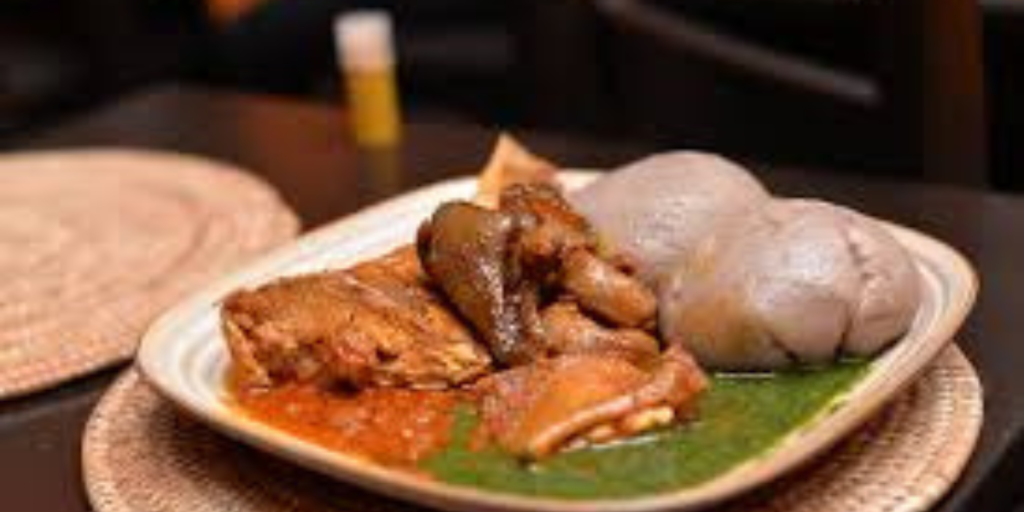
Ewa Agoyin is a popular Nigerian dinner idea, particularly favored by the Yoruba people. This dish consists of mashed beans served with a spicy pepper sauce, known as the Agoyin sauce. The beans are typically cooked until they are soft and creamy, while the sauce is made with a combination of onions, dried peppers, and palm oil, giving it a rich, smoky flavor. Ewa Agoyin is a comfort food for many Nigerians and is often enjoyed as a dinner meal, especially after a long day.
Ingredients for Ewa Agoyin
To make Ewa Agoyin, you’ll need:
- Brown or black-eyed beans
- Palm oil
- Dried pepper or ground chili pepper
- Onions
- Salt and seasoning cubes
- Crayfish (optional)
How to Prepare Ewa Agoyin (Nigerian dinner ideas)
Step 1: Cook the Beans
Start by washing the beans thoroughly to remove any dirt or stones. Place the beans in a pot with enough water and boil them until they are very soft and mushy. You can add a pinch of salt towards the end of cooking.
Step 2: Prepare the Agoyin Sauce
While the beans are cooking, prepare the Agoyin sauce. Heat palm oil in a pan until it becomes clear and slightly smoky. Add finely chopped onions and fry until they are caramelized and golden brown. Next, add the dried pepper or ground chili pepper, along with any seasoning cubes and crayfish. Fry the mixture until the sauce turns dark red and has a rich, smoky aroma.
Step 3: Serve
Mash the cooked beans with a spoon or a potato masher to achieve a creamy consistency. Serve the mashed beans with a generous spoonful of the Agoyin sauce on top. Ewa Agoyin is often eaten with bread (Agege bread) or plantains, making it a complete and satisfying dinner meal.
Variations of Ewa Agoyin
- Ewa Agoyin with Plantains: Fried or boiled plantains can be served alongside Ewa Agoyin to add sweetness and balance to the spiciness of the dish.
- Ewa Agoyin with Yam: Some people prefer to serve Ewa Agoyin with boiled yam, creating a heartier dinner option.
The Cultural Significance of Ewa Agoyin in Nigeria ( Nigerian dinner ideas)
Ewa Agoyin has its roots in the Yoruba community but is now enjoyed across Nigeria. It is a popular street food, often sold by vendors who specialize in making the perfect Agoyin sauce. Ewa Agoyin is loved for its simplicity and bold flavors, and it’s a comfort food that many Nigerians associate with home and childhood.
Nutritional Value of Ewa Agoyin
Beans are an excellent source of protein and fiber, making Ewa Agoyin a nutritious and filling meal. The use of palm oil provides healthy fats, while the dried peppers add antioxidants and vitamins. When paired with a starchy side like bread or plantains, Ewa Agoyin becomes a well-rounded dinner option.
6. Chicken Pepper Soup: A Spicy Nigerian Dinner Option ( Nigerian dinner ideas)

Chicken Pepper Soup is a popular Nigerian dinner idea, especially during the colder months or for those recovering from illness. This spicy, broth-based soup is made with a combination of chicken, spices, and herbs, giving it a flavorful and warming effect. It’s a light yet satisfying dinner option, often served with a side of boiled yam, plantains, or rice.
Ingredients for Chicken Pepper Soup
To make Chicken Pepper Soup, you’ll need:
- Chicken (cut into pieces)
- Pepper soup spices (uziza, uda, alligator pepper, etc.)
- Fresh pepper (scotch bonnet or chili pepper)
- Onions
- Seasoning cubes
- Scent leaves or basil leaves
- Salt and pepper to taste
- Water
How to Prepare Chicken Pepper Soup ( Nigerian dinner ideas)
Step 1: Prepare the Chicken
Start by washing the chicken pieces thoroughly and placing them in a pot. Add chopped onions, seasoning cubes, salt, and water to cover the chicken. Bring the mixture to a boil and let it simmer for about 10 minutes.
Step 2: Add the Spices
Once the chicken has started to cook, add the pepper soup spices, fresh pepper, and any additional seasonings. Continue cooking the soup on low heat, allowing the chicken to absorb the flavors of the spices.
Step 3: Add Scent Leaves
When the chicken is tender, add chopped scent leaves or basil to the soup. These herbs add a fresh, aromatic flavor to the dish. Let the soup simmer for another 5 minutes before serving.
Step 4: Serve
Chicken Pepper Soup is best enjoyed hot, with a side of boiled yam, plantains, or even rice. The broth is flavorful and spicy, making it the perfect comfort food for dinner.
Variations of Chicken Pepper Soup
- Goat Meat Pepper Soup: This variation uses goat meat instead of chicken and has a stronger, more gamey flavor.
- Fish Pepper Soup: For those who prefer seafood, fish pepper soup is a lighter option that is equally delicious.
The Cultural Significance of Chicken Pepper Soup in Nigeria
Pepper soup is a staple dish in Nigerian cuisine, often served at gatherings, parties, or as a comforting meal when someone is feeling under the weather. The dish is loved for its bold, spicy flavors, and it’s commonly believed that the heat from the peppers can help alleviate cold symptoms. Chicken Pepper Soup is also considered an aphrodisiac in some cultures, further adding to its appeal.
Nutritional Value of Chicken Pepper Soup ( Nigerian dinner ideas)
Chicken Pepper Soup is a low-calorie, high-protein dish. The use of fresh herbs and spices adds antioxidants and vitamins, while the broth provides hydration. The soup is also rich in lean protein from the chicken, making it a healthy and nutritious dinner option.
7. Spaghetti: A Nigerian Twist on an International Favorite ( Nigerian dinner ideas)

Though spaghetti is originally an Italian dish, it has become a staple dinner idea in many Nigerian households. Nigerian spaghetti is typically prepared with a variety of seasonings, vegetables, and proteins, giving it a unique flavor that sets it apart from its Western counterpart. This dish is quick to prepare and versatile, making it a popular choice for dinner.
Ingredients for Nigerian Spaghetti
To make Nigerian Spaghetti, you’ll need:
- Spaghetti pasta
- Tomatoes (fresh or paste)
- Bell peppers and onions
- Carrots, peas, and other mixed vegetables
- Ground beef, chicken, or shrimp
- Vegetable oil
- Seasoning cubes
- Salt and pepper to taste
How to Prepare Nigerian Spaghetti
Step 1: Cook the Spaghetti
Begin by boiling water in a large pot. Add a pinch of salt and a little vegetable oil to the water to prevent the spaghetti from sticking together. Cook the spaghetti according to the package instructions, then drain and set aside.
Step 2: Prepare the Sauce
In a separate pan, heat vegetable oil and sauté chopped onions, bell peppers, and tomatoes. Add the ground beef or chicken and cook until the meat is browned. Next, add seasoning cubes, salt, and any other spices you prefer.
Step 3: Add Vegetables
Once the meat is cooked, add your vegetables (carrots, peas, etc.) to the sauce. Let the vegetables simmer for a few minutes until they are tender.
Step 4: Combine the Spaghetti and Sauce
Finally, add the cooked spaghetti to the sauce and mix well, ensuring that the pasta is evenly coated with the sauce. Let the mixture cook for an additional 5 minutes, allowing the flavors to meld together.
Step 5: Serve
Nigerian Spaghetti is typically served hot and can be garnished with grated cheese or chopped herbs for extra flavor. It’s a complete meal that’s both filling and delicious.
Variations of Nigerian Spaghetti ( Nigerian dinner ideas)
- Jollof Spaghetti: This variation mimics the flavor of Jollof Rice by using the same tomato and pepper base for the sauce. It’s a spicy, flavorful option that’s perfect for dinner.
- Vegetarian Spaghetti: For a lighter meal, skip the meat and load up on vegetables like bell peppers, carrots, and peas.
The Cultural Significance of Spaghetti in Nigeria
Spaghetti has become a go-to dinner option for many Nigerians due to its quick cooking time and versatility. It’s often served as a weeknight dinner for busy families and is loved by both children and adults alike. While it may have Italian origins, Nigerian Spaghetti has taken on a life of its own, with unique flavors and ingredients that reflect the country’s diverse palate.
Nutritional Value of Nigerian Spaghetti
Spaghetti is a great source of carbohydrates, which provide energy for the body. When combined with vegetables and proteins, it becomes a well-balanced meal that is both nutritious and satisfying. The addition of mixed vegetables increases the fiber content, making it a healthier dinner option.
8. Goat Meat Pepper Soup: A Savory Nigerian Dinner Idea ( Nigerian dinner ideas)
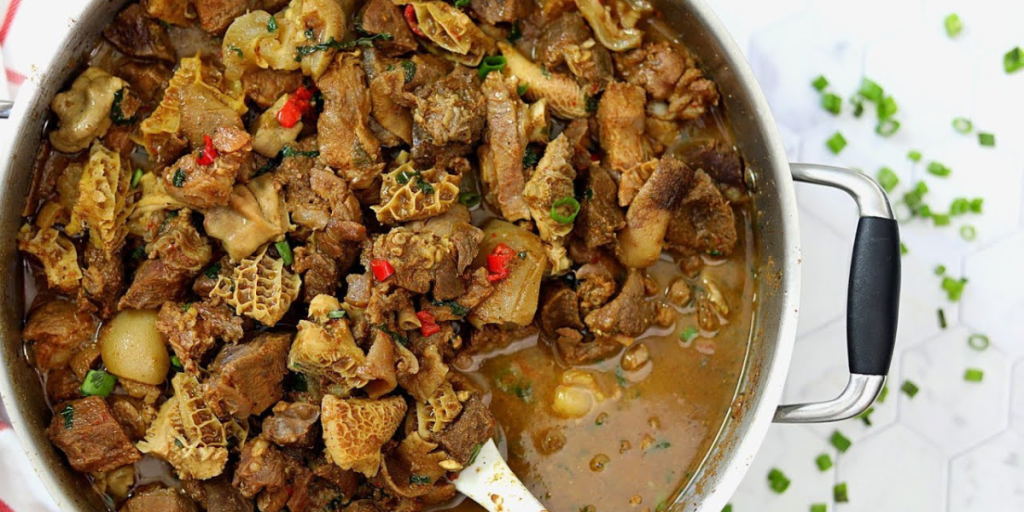
Goat Meat Pepper Soup is another popular Nigerian dinner idea, especially favored for its rich, spicy, and aromatic flavors. Like chicken pepper soup, goat meat pepper soup is a light yet flavorful dish, typically enjoyed with a side of rice, yam, or plantains. The goat meat, often cut into chunks with some bone, absorbs the spices and herbs, making the dish incredibly flavorful and hearty.
Ingredients for Goat Meat Pepper Soup
To make goat meat pepper soup, you’ll need:
- Goat meat (cut into pieces with some bone)
- Pepper soup spices (uziza seeds, uda pods, alligator pepper)
- Fresh pepper (scotch bonnet or habanero)
- Onions
- Scent leaves or basil leaves
- Seasoning cubes
- Salt and pepper to taste
- Water
How to Prepare Goat Meat Pepper Soup
Step 1: Season and Boil the Goat Meat
Start by thoroughly washing the goat meat and placing it in a large pot. Add chopped onions, seasoning cubes, salt, and enough water to cover the meat. Bring it to a boil and cook until the goat meat is tender, adding more water if necessary.
Step 2: Add Pepper Soup Spices
Once the goat meat is soft and well-cooked, add the pepper soup spices, fresh pepper, and any additional seasoning. Stir the mixture and allow it to simmer on low heat for another 10-15 minutes, so the meat absorbs all the flavors.
Step 3: Add Scent Leaves
Towards the end of the cooking process, add chopped scent leaves or basil leaves to give the soup a fresh, aromatic touch. Let it simmer for a few more minutes to allow the leaves to infuse their flavor into the broth.
Step 4: Serve
Serve Goat Meat Pepper Soup hot with a side of rice, yam, or plantains. This hearty and spicy soup is perfect for dinner, especially during the colder months or when you’re craving something comforting.
Variations of Goat Meat Pepper Soup( Nigerian dinner ideas)
- Goat Meat and Fish Pepper Soup: Some people combine goat meat with fresh fish to create a richer and more varied flavor profile.
- Thickened Pepper Soup: In some regions, pepper soup is thickened with yam or cocoyam to give it a more stew-like consistency, making it more filling for dinner.
The Cultural Significance of Goat Meat Pepper Soup in Nigeria
Pepper soup is one of the most beloved and culturally significant dishes in Nigeria, often served at social gatherings, parties, and celebrations. Goat meat pepper soup, in particular, is enjoyed across various regions in Nigeria, with slight variations in the spices used. It is known for its ability to “warm up” the body, and is often considered a comfort food, especially for dinner during the rainy or cold seasons.
Nutritional Value of Goat Meat Pepper Soup
Goat meat is a lean source of protein, making it a healthy alternative to beef or pork. It is lower in fat and calories, while still providing essential nutrients such as iron, zinc, and vitamin B12. The pepper soup spices and fresh herbs used in the dish also contribute antioxidants, making it both nutritious and delicious.
9. Nkwobi: A Special Nigerian Dinner Treat ( Nigerian dinner ideas)
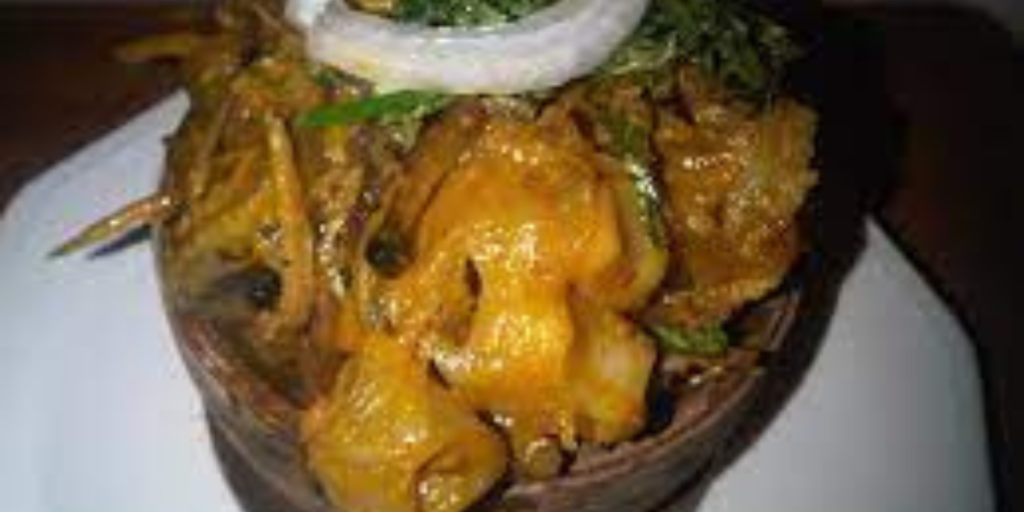
Nkwobi is a traditional Igbo delicacy made from cow feet (also known as cow trotters) and is typically served as a special treat for dinner or at parties. The cow feet are cooked until tender and then coated in a spicy, flavorful palm oil-based sauce that’s rich in spices and seasoning. Nkwobi is a favorite among meat lovers and is often served in traditional wooden bowls with fresh vegetables for garnish.
Ingredients for Nkwobi
To make Nkwobi, you’ll need:
- Cow feet (cut into small pieces)
- Palm oil
- Potash (Akanwu)
- Ground crayfish
- Fresh pepper (scotch bonnet or chili pepper)
- Onions (for garnish)
- Utazi leaves (for garnish)
- Seasoning cubes
- Salt to taste
- Water
How to Prepare Nkwobi
Step 1: Boil the Cow Feet
Begin by thoroughly cleaning the cow feet, then place them in a pot with water, seasoning cubes, and salt. Boil the cow feet until they are very tender. This can take up to an hour or more, depending on how soft you want the meat to be.
Step 2: Prepare the Palm Oil Sauce
In a separate bowl, dissolve a small amount of potash (Akanwu) in water. Gradually add the potash solution to palm oil, stirring continuously until the palm oil turns into a thick, yellowish emulsion. Be careful not to use too much potash, as it can alter the flavor of the dish.
Step 3: Add Spices and Seasoning
To the palm oil mixture, add ground crayfish, fresh pepper, and a bit of salt. Stir the mixture until it becomes a thick, well-seasoned sauce.
Step 4: Combine the Cow Feet with the Sauce
Once the cow feet are tender, drain any excess water and mix the cow feet with the prepared palm oil sauce. Ensure that the cow feet are evenly coated with the sauce, and let it simmer for a few minutes to allow the flavors to blend together.
Step 5: Serve and Garnish
Serve Nkwobi hot in a traditional wooden bowl or plate, and garnish with sliced onions and utazi leaves. The onions add a crunchy texture, while the slightly bitter utazi leaves balance the rich flavors of the dish.
Variations of Nkwobi
- Isi Ewu (Goat Head Nkwobi): Isi Ewu is a similar dish made with goat head instead of cow feet, offering a slightly different flavor and texture.
- Spiced Nkwobi: Some variations of Nkwobi include additional spices such as uziza or alligator pepper to give it a more intense flavor.
The Cultural Significance of Nkwobi in Nigeria
Nkwobi is a popular dish among the Igbo people and is often enjoyed at traditional events, gatherings, and as a special dinner treat. It is considered a delicacy and is typically served with drinks, making it a favorite at bars and local restaurants. Nkwobi is also a communal dish, often shared among friends and family during celebrations.
Nutritional Value of Nkwobi
Cow feet are a good source of collagen, which is beneficial for skin, joints, and bones. The dish is also rich in protein and healthy fats from the palm oil. However, because of its high fat content, Nkwobi is best enjoyed in moderation as part of a balanced diet.
10. Pounded Yam and Egusi Soup: A Classic Nigerian Dinner ( Nigerian dinner ideas)
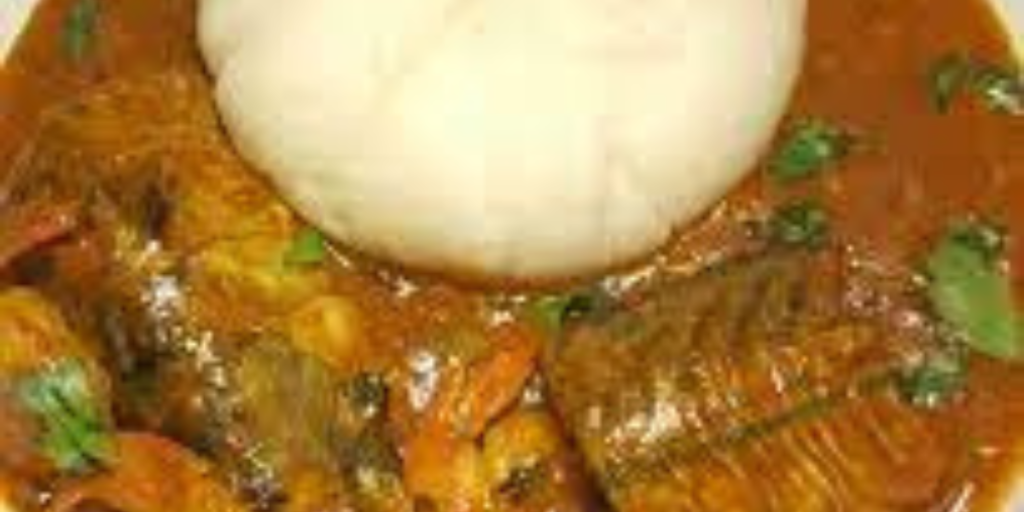
Pounded Yam and Egusi Soup is one of the most iconic Nigerian dinner ideas. Pounded yam is made by pounding boiled yam until it becomes smooth and stretchy, while Egusi soup is a thick, rich soup made from ground melon seeds (Egusi), vegetables, and various proteins. This combination is a staple in many Nigerian households and is often enjoyed as a hearty, satisfying dinner.
Ingredients for Pounded Yam
To make Pounded Yam, you’ll need:
- Yam tubers (peeled and cut into pieces)
- Water
How to Prepare Pounded Yam
Step 1: Boil the Yam
Start by peeling the yam tubers and cutting them into small pieces. Place the yam pieces in a pot with water and boil them until they are soft and fully cooked.
Step 2: Pound the Yam
Once the yam is cooked, drain the water and place the yam pieces in a large mortar. Use a pestle to pound the yam until it becomes smooth and stretchy. Alternatively, you can use a food processor or a yam pounding machine to achieve the same result.
Step 3: Mold and Serve
After pounding the yam, mold it into round or oval balls and serve hot with Egusi soup or any other Nigerian soup of your choice.
Ingredients for Egusi Soup
To make Egusi Soup, you’ll need:
- Ground Egusi (melon seeds)
- Palm oil
- Spinach or pumpkin leaves (ugu)
- Fresh pepper (scotch bonnet)
- Onions
- Meat or fish (goat meat, beef, or dried fish)
- Crayfish (optional)
- Stock cubes
- Salt and pepper to taste
How to Prepare Egusi Soup
Step 1: Fry the Egusi
In a large pot, heat palm oil and add chopped onions. Fry the ground Egusi in the palm oil, stirring continuously to prevent it from burning. The Egusi should fry for a few minutes until it becomes fragrant and slightly golden.
Step 2: Add Meat and Stock
Once the Egusi is well fried, add your choice of meat or fish to the pot, along with some stock or water. Stir the mixture and allow it to cook for about 10 minutes so that the meat absorbs the flavors of the Egusi.
Step 3: Add Vegetables and Seasoning
Next, add chopped spinach or pumpkin leaves to the soup, along with fresh pepper, crayfish, and stock cubes. Let the soup simmer for another 10-15 minutes, stirring occasionally to ensure that the ingredients are well combined.
Step 4: Serve with Pounded Yam
Once the Egusi soup is ready, serve it hot with freshly pounded yam. This combination is hearty, filling, and bursting with flavor, making it the perfect dinner choice for special occasions or everyday meals.
Conclusion (continued)
In addition to the previously discussed dishes, it’s important to recognize the adaptability and creativity that defines Nigerian cuisine. Whether you are hosting a large gathering, celebrating a special occasion, or simply enjoying a meal with family, these Nigerian dinner ideas can serve as a delightful centerpiece. Each dish brings its own story, tradition, and cultural significance to the table, making every meal an experience worth savoring.
The Influence of Regional Variations
Nigerian cuisine is not monolithic; it varies significantly from one region to another, reflecting local ingredients, cultural practices, and culinary techniques. For instance, while fried rice and jollof rice are enjoyed across the country, their preparation might differ slightly based on the region, with unique spices or additional ingredients added for flair. Understanding these regional nuances not only enriches your dining experience but also allows you to appreciate the diversity within Nigerian cooking.
Explore More Nigerian Dinner Ideas
As you continue to explore Nigerian dinner ideas, consider experimenting with different dishes or combining elements from various recipes. Here are some additional ideas to inspire your culinary adventures:
- Bitterleaf Soup: A thick and flavorful soup made with bitter leaves, often enjoyed with pounded yam or rice. It’s known for its unique flavor profile and health benefits.
- Fried Plantains: A versatile side dish that pairs well with many Nigerian meals. They can be fried until golden brown for a sweet and savory addition to your dinner plate.
- Peppered Chicken: Marinated and grilled or fried chicken seasoned with a spicy pepper sauce. This dish is a favorite at parties and gatherings.
- Moi Moi: A steamed bean pudding made from blended black-eyed peas, spices, and optional fillings like fish or eggs. It can be served as a side or main dish.
- Banga Soup: A rich palm nut soup often served with pounded yam or rice, packed with flavor from spices and proteins.
- Nkwobi with Ugu: Adding ugu (pumpkin leaves) to your Nkwobi can enhance the nutritional value and provide a delightful crunch to the dish.
- Efo Riro: A savory vegetable soup made with spinach or other leafy greens, often enjoyed with rice or fufu.
- Pepper Sauce Fish: Grilled or fried fish coated in a spicy pepper sauce, a flavorful and healthy dinner option.
- Yam Porridge: A comforting dish made with yam, vegetables, and spices, often enjoyed on colder nights.
- Catfish Pepper Soup: Similar to goat meat pepper soup, but made with fresh catfish, offering a different taste experience.
Final Thoughts on Nigerian Dinner Ideas
Incorporating these Nigerian dinner ideas into your cooking repertoire can transform your dining experience, introducing bold flavors and inviting culinary traditions into your home. Whether you choose to explore the depths of traditional dishes or experiment with modern interpretations, each meal is an opportunity to celebrate the vibrant culture and history of Nigeria.
Encouraging family and friends to gather around the dinner table to enjoy these delightful dishes fosters connection and community, making every meal a memorable occasion. By sharing these recipes and stories, you can help spread the love and appreciation for Nigerian cuisine, allowing others to discover the joy that comes from cooking and sharing these amazing dishes.
As you embark on your culinary journey through Nigerian cuisine, remember that cooking is an art and a science. Don’t be afraid to experiment with flavors, adjust ingredients to suit your taste, and most importantly, have fun in the kitchen. Enjoy the process of cooking, and let the delightful aromas and flavors of Nigerian dinner ideas fill your home and your heart.
Explore the rich culinary landscape of Nigeria with these top ten dinner ideas, and bring the spirit of Nigerian hospitality to your dining experience!
















